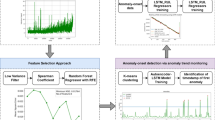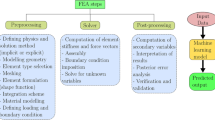Abstract
In this study, the deep learning models for estimating the mechanical properties of concrete containing silica fume subjected to high temperatures were devised. Silica fume was used at concentrations of 0%, 5%, 10%, and 20%. Cube specimens (100 mm × 100 mm × 100 mm) were prepared for testing the compressive strength and ultrasonic pulse velocity. They were cured at 20°C±2°C in a standard cure for 7, 28, and 90 d. After curing, they were subjected to temperatures of 20°C, 200°C, 400°C, 600°C, and 800°C. Two well-known deep learning approaches, i.e., stacked autoencoders and long short-term memory (LSTM) networks, were used for forecasting the compressive strength and ultrasonic pulse velocity of concrete containing silica fume subjected to high temperatures. The forecasting experiments were carried out using MATLAB deep learning and neural network tools, respectively. Various statistical measures were used to validate the prediction performances of both the approaches. This study found that the LSTM network achieved better results than the stacked autoencoders. In addition, this study found that deep learning, which has a very good prediction ability with little experimental data, was a convenient method for civil engineering.
Similar content being viewed by others
References
Schneider U. Concrete at high temperatures—A general review. Fire Safety Journal, 1988, 13(1): 55–68
Phan L T. Fire performance of high-strength concrete: A report of the state-of-the art, building and fire research laboratory. Nistir, 1996, 5934: 1–105
Poon C S, Azhar S, Anson M, Wong Y L. Performance of metakaolin concrete at elevated temperatures. Cement and Concrete Composites, 2003, 25(1): 83–89
Tanyildizi H, Asilturk E. Performance of phosphazene-containing polymer-strengthened concrete after exposure to high temperatures. Journal of Materials in Civil Engineering, 2018, 30(12): 04018329
Tanyildizi H, Şahin M. Taguchi optimization approach for the polypropylene fiber reinforced concrete strengthening with polymer after high temperature. Structural and Multidisciplinary Optimization, 2017, 55(2): 529–534
Tanyildizi H, Asiltürk E. High temperature resistance of polymerphosphazene concrete for 365 days. Construction & Building Materials, 2018, 174: 741–748
Varona F B, Baeza F J, Bru D, Ivorra S. Influence of high temperature on the mechanical properties of hybrid fibre reinforced normal and high strength concrete. Construction & Building Materials, 2018, 159: 73–82
Poon C S, Azhar S, Anson M, Wong Y L. Strength and durability recovery of fire-damaged concrete after post-fire-curing. Cement and Concrete Research, 2001, 31(9): 1307–1318
de Oliveira Dias A R, Amancio F A, de Carvalho Rafael M F, Bezerra Cabral A E. Study of propagation of ultrasonic pulses in concrete exposed at high temperatures. Procedia Structural Integrity, 2018, 11: 84–90
Haddad R H, Shannis L G. Post-fire behavior of bond between high strength pozzolanic concrete and reinforcing steel. Construction & Building Materials, 2004, 18(6): 425–435
Husem M. The effects of high temperature on compressive and flexural strengths of ordinary and high-performance concrete. Fire Safety Journal, 2006, 41(2): 155–163
Wu B, Yu Y, Zhao X Y. Residual mechanical properties of compound concrete containing demolished concrete lumps after exposure to high temperatures. Fire Safety Journal, 2019, 105: 62–78
Lin W M, Lin T D, Powers-Couche L J. Microstructures of fire-damaged concrete. ACI Materials Journal, 1996, 93: 199–205
Arioz O. Effects of elevated temperatures on properties of concrete. Fire Safety Journal, 2007, 42(8): 516–522
Anwar Hossain K M. High strength blended cement concrete incorporating volcanic ash: Performance at high temperatures. Cement and Concrete Composites, 2006, 28(6): 535–545
Tanyıldızı H. Post-fire behavior of structural lightweight concrete designed by Taguchi method. Construction & Building Materials, 2014, 68: 565–571
Tanyildizi H, Coskun A, Somunkiran I. An experimental investigation of bond and compressive strength of concrete with mineral admixtures at high temperatures. Arabian Journal for Science and Engineering, 2008, 33(2): 443–449
Biolzi L, Cattaneo S, Rosati G. Evaluating residual properties of thermally damaged concrete. Cement and Concrete Composites, 2008, 30(10): 907–916
Schneider U, Diederichs U, Ehm C. Effect of temperature on steel and concrete for PCRV’s. Nuclear Engineering and Design, 1982, 67(2): 245–258
Ma Q, Guo R, Zhao Z, Lin Z, He K. Mechanical properties of concrete at high temperature—A review. Construction & Building Materials, 2015, 93: 371–383
Poon C S, Azhar S, Anson M, Wong Y L. Comparison of the strength and durability performance of normal- and high-strength pozzolanic concretes at elevated temperatures. Cement and Concrete Research, 2001, 31(9): 1291–1300
Behnood A, Ziari H. Effects of silica fume addition and water to cement ratio on the properties of high-strength concrete after exposure to high temperatures. Cement and Concrete Composites, 2008, 30(2): 106–112
Ni H G, Wang J Z. Prediction of compressive strength of concrete by neural networks. Cement and Concrete Research, 2000, 30(8): 1245–1250
Bilim C, Atiş C D, Tanyildizi H, Karahan O. Predicting the compressive strength of ground granulated blast furnace slag concrete using artificial neural network. Advances in Engineering Software, 2009, 40(5): 334–340
Topçu I B, Saridemir M. Prediction of compressive strength of concrete containing fly ash using artificial neural networks and fuzzy logic. Computational Materials Science, 2008, 41(3): 305–311
Karahan O, Tanyildizi H, Atis C D. An artificial neural network approach for prediction of long-term strength properties of steel fiber reinforced concrete containing fly ash. Journal of Zhejiang University. Science A, 2008, 9(11): 1514–1523
Duan Z H, Kou S C, Poon C S. Prediction of compressive strength of recycled aggregate concrete using artificial neural networks. Construction & Building Materials, 2013, 40: 1200–1206
Tanyildizi H. Prediction of the strength properties of carbon fiber-reinforced lightweight concrete exposed to the high temperature using artificial neural network and support vector machine. Advances in Civil Engineering, 2018, 2018: 1–10
Sarıdemir M. Prediction of compressive strength of concretes containing metakaolin and silica fume by artificial neural networks. Advances in Engineering Software, 2009, 40(5): 350–355
Tanyildizi H. Prediction of compressive strength of lightweight mortar exposed to sulfate attack. Computers and Concrete, 2017, 19(2): 217–226
Cha Y J, Choi W, Büyüköztürk O. Deep learning-based crack damage detection using convolutional neural networks. Computer-Aided Civil and Infrastructure Engineering, 2017, 32(5): 361–378
Zhang A, Wang K C P, Li B, Yang E, Dai X, Peng Y, Fei Y, Liu Y, Li J Q, Chen C. Automated pixel-level pavement crack detection on 3d asphalt surfaces using a deep-learning network. Computer-Aided Civil and Infrastructure Engineering, 2017, 32(10): 805–819
Lin Y Z, Nie Z H, Ma H W. Structural damage detection with automatic feature-extraction through deep learning. Computer-Aided Civil and Infrastructure Engineering, 2017, 32(12): 1025–1046
Deng F, He Y, Zhou S, Yu Y, Cheng H, Wu X. Compressive strength prediction of recycled concrete based on deep learning. Construction & Building Materials, 2018, 175: 562–569
Anitescu C, Atroshchenko E, Alajlan N, Rabczuk T. Artificial neural network methods for the solution of second order boundary value problems. Computers. Materials & Continua, 2019, 59(1): 345–359
Guo H, Zhuang X, Rabczuk T. A deep collocation method for the bending analysis of Kirchhoff plate. Computers, Materials & Continua, 2019, 59(2): 433–456
Rabczuk T, Ren H, Zhuang X. A Nonlocal operator method for partial differential equations with application to electromagnetic waveguide problem. Computers, Materials & Continua, 2019, 59(1): 31–55
Mohamedbhai G T G. Effect of exposure time and rates of heating and cooling on residual strength of heated concrete. Magazine of Concrete Research, 1986, 38(136): 151–158
Chan Y N, Peng G F, Anson M. Residual strength and pore structure of high-strength concrete and normal strength concrete after exposure to high temperatures. Cement and Concrete Composites, 1999, 21(1): 23–27
Krizhevsky A, Sutskever I, Hinton G E. ImageNet classification with deep convolutional neural networks. Advances in Neural Information Processing Systems, 2012, 25(2): 1097–1105
Hochreiter S, Schmidhuber J. Long short-term memory. Neural Computation, 1997, 9(8): 1735–1780
Liu Y, Qin Y, Guo J, Cai C, Wang Y, Jia L. Short-term forecasting of rail transit passenger flow based on long short-term memory neural network. In: 2018 International Conference on Intelligent Rail Transportation. Singapore, 2018, 1–5
Gers F A, Schraudolph N N, Schmidhuber J. Learning precise timing with LSTM recurrent networks. Journal of Machine Learning Research, 2003, 3: 115–143
Liu G, Bao H, Han B. A stacked autoencoder-based deep neural network for achieving gearbox fault diagnosis. Mathematical Problems in Engineering, 2018, 2018: 1–10
Xie J, Zhang Z, Lu Z, Sun M. Coupling effects of silica fume and steel-fiber on the compressive behaviour of recycled aggregate concrete after exposure to elevated temperature. Construction & Building Materials, 2018, 184: 752–764
Esen H, Ozgen F, Esen M, Sengur A. Artificial neural network and wavelet neural network approaches for modelling of a solar air heater. Expert Systems with Applications, 2009, 36(8): 11240–11248
Esen H, Inalli M, Sengur A, Esen M. Artificial neural networks and adaptive neuro-fuzzy assessments for ground-coupled heat pump system. Energy and Building, 2008, 40(6): 1074–1083
Acknowledgements
The experimental part of this study was supported by the Firat University BAPYB (Project No. TEF.12.04). The authors gratefully acknowledge the Firat University of BAPYB.
Author information
Authors and Affiliations
Corresponding author
Rights and permissions
About this article
Cite this article
Tanyildizi, H., Şengür, A., Akbulut, Y. et al. Deep learning model for estimating the mechanical properties of concrete containing silica fume exposed to high temperatures. Front. Struct. Civ. Eng. 14, 1316–1330 (2020). https://doi.org/10.1007/s11709-020-0646-z
Received:
Accepted:
Published:
Issue Date:
DOI: https://doi.org/10.1007/s11709-020-0646-z




